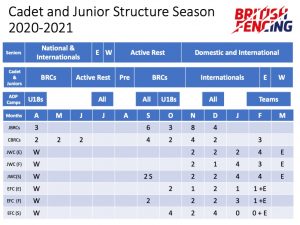

The 2020-21 Cadet and Junior season will be based on a model which is structured around recognised competition windows. The model is being published to support competition planning, competition periodisation and help parents, coaches and fencers select the most appropriate competitions based on target goals, stages of development and actual competition results.

The associated lists of ranking and qualification events will ensure that competition and representative fencing is delivered across the country at a consistent time. These events will be divided into the competition windows.
The structuring of the season in this way and the advance communication is in part a response to feedback from the community in the following areas:
To be competitive a fencing nation we recognise the need to increase the level of domestic and international competition experience available for our fencers. We must also have more movement in the ranking lists to reduce potential fencer complacency.
The windows have been implemented to reduce competition clashes. They will help to limit the amount of selection/deselection and the resulting need for fencers over attendance /under attendance in the various competition.
For Cadet and Juniors, there are 4 competition windows:
April – June Domestic Season Part 1. These early BRCs allow fencers and particularly new fencers moving into those age ranges to gain an understanding of where their current level is and to the use the “Active Rest” section to undertake targeted work, such as their technical improvement areas or conditioning programmes to meet the demand of the age group.
For the Cadets, it allows an early selection for the early European Fencing Confederation competitions and also informs the content for the August ADP camps.
September – November Domestic Season Part 2. Adding to the data garnered in part 1, these BRCs start to define those at the correct performance standards to represent GBR at the international level. This informs the selection for the international circuit that runs from November to February. It will also highlight those fencers that need more time and experience to move towards these standards. This may be the UK domestic circuit or domestic circuits in the European counties.
November – February International Competitions. For those that have met the performance standards, the opportunity to focus on gaining experience of international competition and achieving qualification points towards the Major Championships. There are still some BRCs to afford some small opportunity to be selected for international ranking competitions. This window can also be used by fencers to gain international experience in preparation for the next season by attending competitions in other countries’ competition circuits.
February – April Major Championships. In this section, there are two defined groups: Firstly those 24-48 fencers taking part in the European and World Championships. Secondly, the fencers taking part in the British Youth Championship (BYCs) regional qualifiers, working towards the final event in May. This will also be the stage where some fencers will undertake a higher age group competition, such as the European U23 circuit or Senior World Cup Circuit.
Finally, there is also recognition that our Cadet and Junior fencers have other demands on them and life balance is important. Research findings strongly suggest that students revising for their GCSEs or A-levels should not abandon sport as it can help some young people thrive when in stressful situations. Competition spread over a longer period with a break in the programme means that fencers can forgo a domestic competition and have the opportunity to recover to meet a performance standard to meet the selection requirements.

Sign up to receive regular highlights from the exciting world of fencing - celebrating the best of our unique and inspiring community